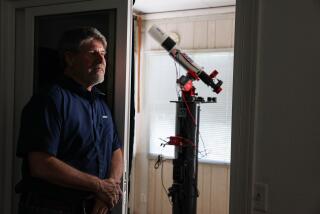Scientists Trace Cosmic Blast to Unusual Star
- Share via
An intense blast from a bizarre new species of star electrified Earth’s upper atmosphere last month, marking the first time astronomers have tracked a local disturbance to a distant sun.
Although the radiation didn’t reach the Earth’s surface, it did briefly knock out several orbiting satellites and registered off the scale on the radiation detectors of at least five others, astronomers announced Tuesday at a NASA press briefing. Produced by a massive “starquake” on a so-called magnetar 23,000 light-years from Earth, the blast was powered by a magnetic field 100 times stronger than any previously known in the universe and billions of times stronger than any on Earth, researchers believe.
The Aug. 27 burst wasn’t announced until Tuesday, astronomers said, because it took them almost a month to figure out exactly what they were seeing, according to UC Berkeley’s Kevin Hurley. “I had never seen anything like it,” he said.
After the initial blast, the star “rang” in X-rays for several minutes, producing an “unheard of” tone, Hurley said.
If confirmed, the discovery adds a new category of object to the already bizarre collection in the skies. Magnetars flare up for a brief (in astronomical terms) 10,000 to 40,000 years before running out of steam.
“It’s magnificent while it’s alive, but it dies quickly,” said Caltech graduate student Joshua Bloom, who studied the radio afterglow of the outburst with the National Science Foundation’s Very Large Array Telescope. He works with Caltech astrophysicist Shri Kulkarni. “It implies there is this graveyard of once-powerful objects out there.”
NASA astronomer Chryssa Kouveliotou estimated that millions of burned-out magnetars might be roaming the galaxy. Magnetars are rare variations on neutron stars--already one of the strangest species in the cosmos. Remnants of massive stars that burn up their nuclear fuel, explode and then collapse, neutron stars are unimaginably dense: A tablespoon of the neutron fluid inside would weigh as much as an aircraft carrier, said Rob Duncan, a theorist at the University of Texas at Austin who had predicted the existence of magnetars.
If the collapsing star is spinning rapidly, he said, it could trap the magnetic field from the star, compressing and magnifying it--eventually producing what Kouveliotou called “the strongest magnetic field ever seen anywhere in the cosmos.” (Earth’s paltry field, by comparison, is a thousand trillion times weaker.)
Such an immense field would sap the star’s spin, effectively acting as a brake. The astronomers detected a distinctive slowing of the ring frequency, signaling that the rapidly spinning star was indeed slowing down. They calculated that the energy drained into a “humongous” magnetic field, said Kouveliotou, who discovered the first probable magnetar earlier this year.
“It’s been a very good year for magnetars and home runs,” she said.
The powerful field also would stir up the heavy liquid material inside the star enough to crack its 1-mile-thick metal crust, producing a starquake of immense proportions. Both the slowing of the spin and the starquake are thought to be clear signatures of magnetars.
To be confirmed, however, the discovery of magnetars will have to be verified by future tests, Duncan said. “There will be a lot more hurdles.”
Assuming that the theory is correct, if the initial release of energy from the starquake were harnessed, it would be enough to power human civilization until the end of the universe, Hurley said. By the time it got to Earth, however, the shower had all the power of a dental X-ray.
Still, that was enough to substantially, if briefly, boost Earth’s electrically charged ionosphere from its normally quiet nighttime state to daytime levels. The blast, in other words, had the same effect as the sun for a few minutes.
“All this goes to show that the Earth does not exist in splendid isolation,” said Stanford’s Umran Inan, who observed the atmospheric disturbance with the university’s array of radio stations, strung across North America specifically to monitor the ionosphere. “The night turned briefly into day,” he said.
The magnetar hypothesis would explain the behavior of previously mysterious objects known as Soft Gamma Repeaters, or SGRs. Unlike the fierce gamma ray bursts that randomly light up the skies from the far reaches of the cosmos, SGRs produce “softer,” or less energetic, light. They also burst repeatedly, if not always regularly. The first three SGRs were discovered in 1979. The fourth was discovered earlier this year.
Although SGRs don’t produce anywhere near the amount of energy as the onetime “cosmic” gamma ray bursts, the energy they shower toward Earth is about the same, said Bloom, because they are so much closer. Three of the known SGRs lie within the Milky Way; the fourth resides in our neighbor, the Large Magellanic Cloud.
“This is what people have been looking for a long time,” Bloom said. “Until now, we haven’t been able to confirm that [SGRs] are magnetars.”
If magnetars really exist, he said, a starquake would be expected to send out a shower of X-rays, gamma rays and radio signals. Particles also would be created out of the pure energy of the blast, according to Einstein’s famous E=mc2 . The particles in turn would produce the kind of radio emissions seen by Bloom.
“That’s what we were looking for, and that’s what we found,” he said. “Nature was kind.”




